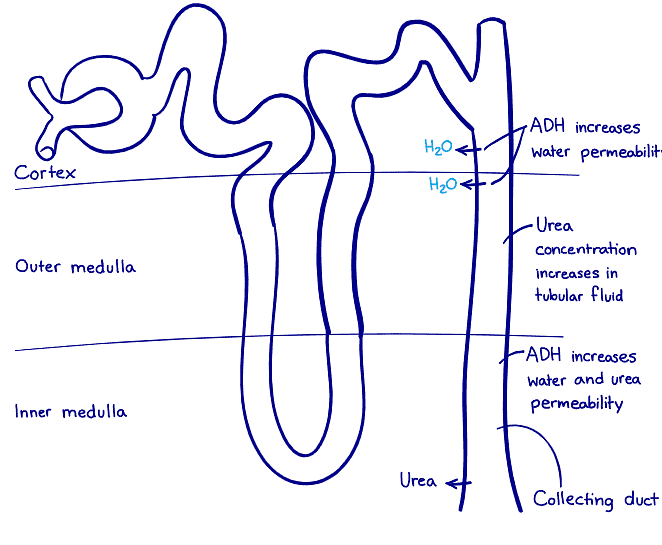MCAT Exam > MCAT Notes > Biology for MCAT > Renal Physiology: Counter Current Multiplication
Renal Physiology: Counter Current Multiplication | Biology for MCAT PDF Download
| Table of contents |

|
| Introduction |

|
| Understanding the Process of Countercurrent Multiplication |

|
| Urea Recycling and Countercurrent Exchange |

|
| Water and Solute Reabsorption Control |

|
Introduction
The kidneys possess a remarkable mechanism called countercurrent multiplication, which allows for efficient reabsorption of water from the tubular fluid. This process plays a crucial role in producing concentrated urine and preventing excessive loss of water. By exploring the details of countercurrent multiplication, we can gain insights into the intricate workings of renal physiology and understand how the kidneys maintain the body's water balance.
The Location: Two Types of Nephrons
The kidneys contain two types of nephrons: superficial cortical nephrons (70-80%) and juxtamedullary nephrons (20-30%). These nephrons are distinguished by the location of their glomerular capsule. Superficial cortical nephrons are positioned in the outer cortex of the kidney, while juxtamedullary nephrons reside near the corticomedullary border. Understanding the structure and function of these nephrons is crucial to grasp the concept of countercurrent multiplication.
- Nephron Sections and Functions: Nephrons can be divided into several sections, each with its own distinct structure and function. These sections include the glomerulus, proximal tubule, loop of Henle, distal tubule, and collecting duct. Among these, the loop of Henle plays a vital role in countercurrent multiplication. It consists of a hairpin-like structure comprising a thin descending limb, a thin ascending limb, and a thick ascending limb. It's important to note that juxtamedullary nephrons have longer loops of Henle, penetrating deep into the inner medulla, while cortical nephrons' loops extend only to the outer medulla.
- Cooperation with the Vasa Recta: While the loops of Henle are responsible for concentrating urine, they don't work alone. The vasa recta, a specialized blood capillary network, plays an equally crucial role. These long, hairpin-shaped blood vessels run parallel to the loops of Henle. The vasa recta's slow blood flow rate helps maintain the necessary osmotic gradient for water reabsorption, thus supporting the process of countercurrent multiplication.
Understanding the Process of Countercurrent Multiplication
- Countercurrent multiplication occurs due to the distinct characteristics of the three segments of the loop of Henle. The thin descending limb is permeable to both water and small solutes such as sodium chloride and urea. As solutes are actively reabsorbed from the ascending limb, the concentration of solutes in the interstitial space increases. Consequently, water moves out of the tubular fluid and solutes move in, leading to a steady increase in tubular fluid concentration.
- The thin ascending limb, on the other hand, is permeable to solutes but impermeable to water. This results in the movement of solutes out of the tubular fluid while water is retained, causing the tubular fluid to become progressively more dilute.
- The thick ascending limb, known as the "diluting segment," actively reabsorbs sodium, potassium, and chloride. Similar to the thin ascending limb, it is also impermeable to water. Countercurrent multiplication efficiently moves sodium chloride from the tubular fluid into the interstitial space within the kidneys, establishing an osmotic gradient.
- The countercurrent multiplication process occurs in two steps: the single effect and fluid flow. The single effect involves active transport of sodium chloride from the tubular fluid in the thick ascending limb to the interstitial fluid, creating a hyperosmotic environment. As a result, water moves passively from the tubular fluid in the descending limb into the interstitial space. With the continuous production of urine, new tubular fluid enters the descending limb, pushing the fluid with higher osmolarity down the loop of Henle and gradually developing an osmotic gradient.
The Role of Antidiuretic Hormone
The concentration of urine is regulated by antidiuretic hormone (ADH), which aids in water conservation by the kidneys. ADH enhances water permeability in the late distal tubule and collecting ducts, increases active transport of sodium chloride in the thick ascending limb of the loop of Henle, and boosts countercurrent multiplication and urea recycling. These effects contribute to the development and maintenance of the osmotic gradient required for water reabsorption.
Urea Recycling and Countercurrent Exchange
Urea recycling in the inner medulla is another factor influencing the osmotic gradient generated by the loops of Henle. ADH increases both water and urea permeability in the inner medullary collecting ducts, allowing urea to flow passively down its concentration gradient into the interstitial fluid. This process intensifies the osmotic gradient, driving water reabsorption.

Water and Solute Reabsorption Control
The kidneys possess the ability to separate the reabsorption of water and solutes in the loop of Henle, distal nephron, and collecting ducts. This separation allows the production of urine with varying concentrations, either more concentrated or more dilute than plasma, depending on the body's hydration status. The release of ADH by the pituitary gland, controlled by sensors detecting changes in blood pressure and salt concentrations, plays a crucial role in regulating this process.
Conclusion
Countercurrent multiplication is a remarkable mechanism employed by the kidneys to reabsorb water and produce concentrated urine. By understanding the structure and function of the loop of Henle, the cooperation with the vasa recta, and the influence of antidiuretic hormone, we can appreciate the complexity and efficiency of renal physiology. The intricate processes of countercurrent multiplication and urea recycling ensure that the kidneys maintain the body's water balance and prevent excessive loss of fluid.
The document Renal Physiology: Counter Current Multiplication | Biology for MCAT is a part of the MCAT Course Biology for MCAT.
All you need of MCAT at this link: MCAT
|
233 videos|16 docs
|

|
Explore Courses for MCAT exam
|

|
Signup for Free!
Signup to see your scores go up within 7 days! Learn & Practice with 1000+ FREE Notes, Videos & Tests.
Related Searches
















